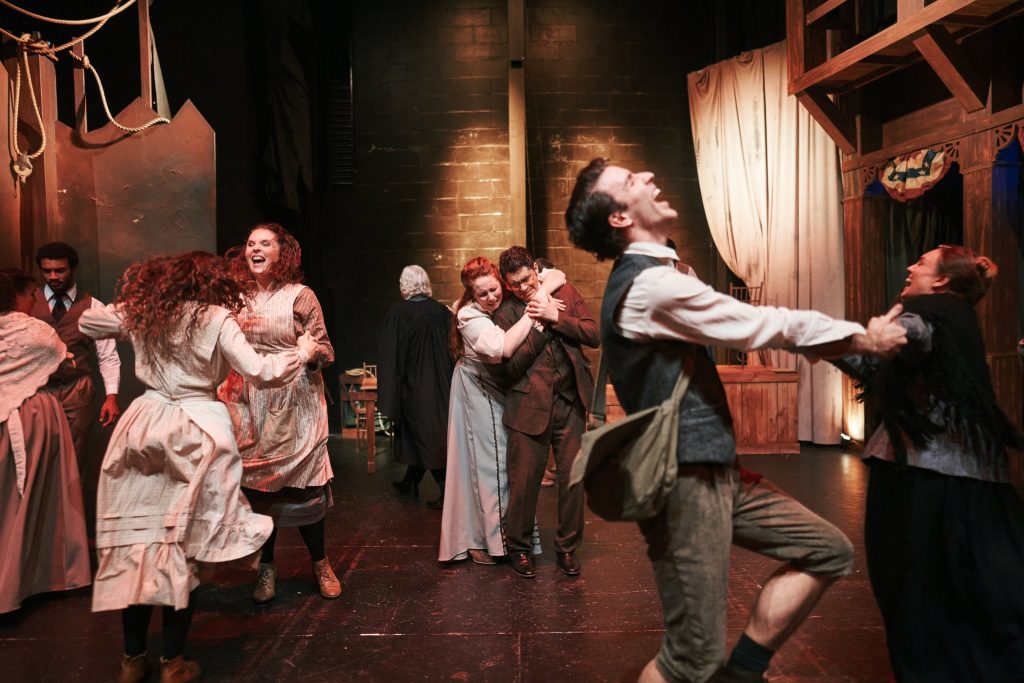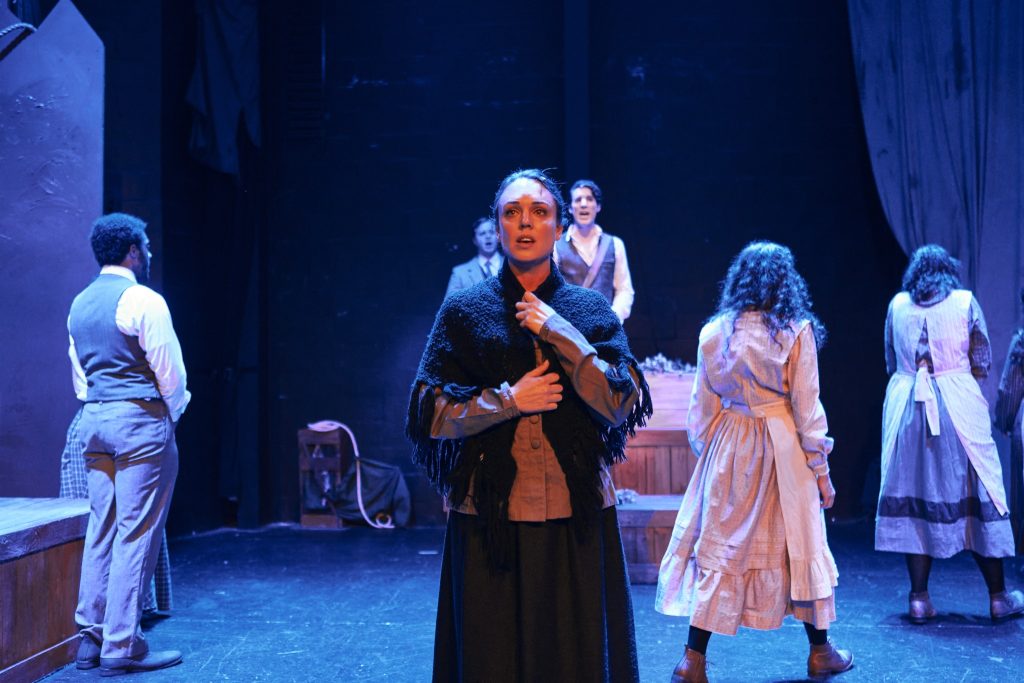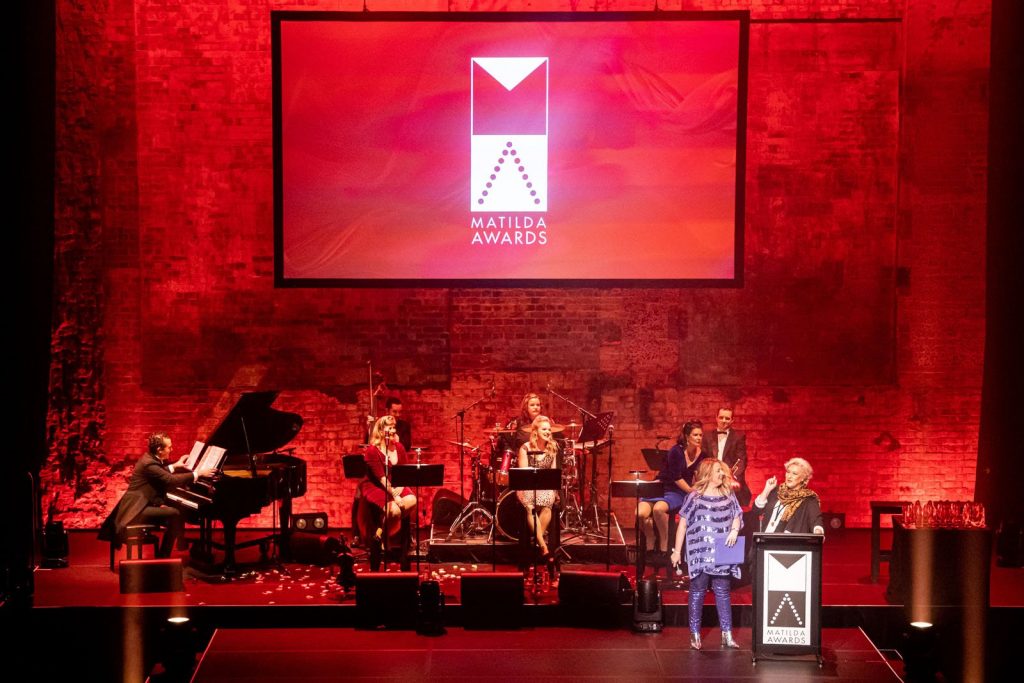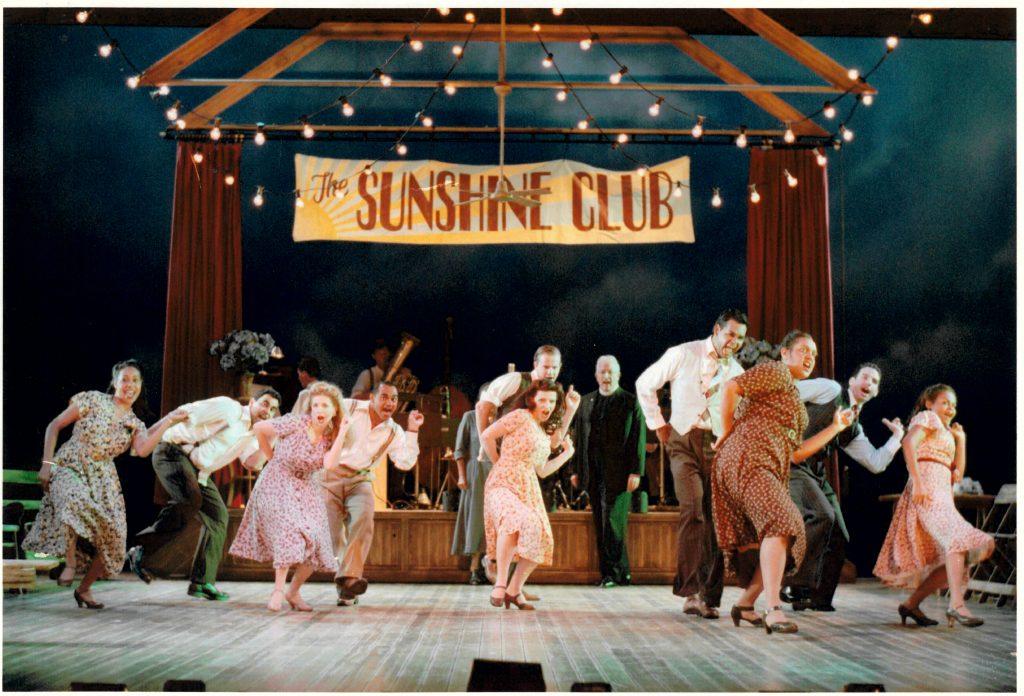
‘Parade’ // Bump In Productions
‘Parade’ was unflinching.
Marching into the Ron Hurley Theatre for a limited season, Bump In Productions’ latest presentation of the rarely-staged ‘Parade’ left a lasting impact on audiences. Presented in one of Brisbane’s most intimate venues, the production was tautly staged, creatively functional, and brave in both its choice of material and how it chose to tell it.
Set in 1913 Georgia, ‘Parade’ follows the story of Leo Frank (Michael Lewis), a Brooklyn-born Jewish factory manager who is wrongfully accused of murdering 13-year-old Mary Phagan (Mabel Tamone). Based on true events, the musical charts a troubling course through anti-Semitism, media frenzy, Southern identity, and the failures of justice. With a score by Jason Robert Brown and book by Alfred Uhry, ‘Parade’ blends folk songs with scorching blues and soaring ballads in a narrative as resonant today as it was over a century ago. For those in Brisbane, Bump In Productions has offered a rare opportunity to experience a show from a neglected corner of the musical theatre canon. While its deeply American roots and subject matter may not immediately connect with every theatregoer, Bump In Production’s ‘Parade’ brought these themes to the surface with enough conviction to make them matter. In a city often filled with well-known titles, ‘Parade’ offered something incredibly different.
In this production, much thought has been given to transforming the limited playing space of the Ron Hurley Theatre into 1900s Georgia, with flecks of the Old South’s patriotic pageantry within the set. Set Design by David Lawrence incorporated elements like elevated timber, red-white-and-blue bunting, and panelled wooden structures that hint at civic spaces (a courthouse, a parade ground, a town square, etc.), all steeped in Southern tradition. Lawrence reduced the footprint of the theatre space and mades use of wooden blocks, adding much-needed levels, which move around the small space to minimistically form jail cells, courtrooms, factory floors and home life, under Johnny Peek’s direction. Scene transitions moved from one into another via either actor-led transitions of moving the wooden blocks or blackouts. Peek used this to keep pace moving; however, some consistency with this could assist with the storytelling. That is, some transitions happened in blackouts, others with actors moving set in half-light or in full wash, which muddied the visual clarity of the narrative. This might have been a cueing issue or simply a case of needing to tighten transitions in the opening weekend. Either way, the concept was strong but would benefit from consistency in execution.
Lighting Design by Zephyr Burns played with a rich contrast of tones, with orange hues emulating the present date, and blue hues for past memory. The simple palette evoked both the warmth and coldness of early 1900s Georgia.
Musical Direction by Michael Keen was a standout, especially considering the limitations of the venue. Positioned in the upstairs balcony, Keen guided a mix of live musicians and tracks to craft a rich and layered sound. From the show’s stirring opener, “The Old Red Hills of Home”, the fullness of the ensemble was evident, and Keen spotlighted the vocal strengths of the cast. Other musical highlights included “You Don’t Know This Man” sung with heartbreak and power by Belinda Lewis as Lucille Frank, and “Feel the Rain Fall”, led by Matthew McKenzie, which used rhythm and body percussion to conjure the raw, percussive energy of Southern blues. The sound, in particular during the latter, felt like it could have been lifted from the American South itself – guttural, full of soul, and alive.
Maureen Bowra’s choreography helped the ensemble through the tight stage space and gave flavour to many scenes. “Come Up To My Office” was a choreographic highlight, finding a clever and subtle way to portray discomfort without leaning on overt depiction. The movement in this number let the tension sit with the audience rather than forcing it upon them.
With a cast of 17, the performers formed a tightly woven ensemble, shifting energy to carry the story’s emotional throughline.
Belinda Lewis as Lucille Frank delivered a performance rich in depth and quiet resolve. She commanded each scene with a poised stillness that gradually unravelled as the stakes rose, especially during the courtroom sequences, where her efforts to maintain composure gave way to something more fractured. As Leo Frank, Michael Lewis tackled what was clearly a bucket-list role, as Michael Lewis was also the show’s Producer. Vocally strong and emotionally invested, Michael Lewis leaned into the character’s discomfort and anxiety. At times, though, this veered into tantrum-like energy that created distance between the character and audience, especially in moments that required vulnerability. Whether intentional or not, it softened the emotional impact of key moments, particularly during the trial.
Mabel Tamone left a lasting impression as Mary Phagan. Though Tamone’s stage time was brief, she brought childlike innocence, which gave weight to the character’s tragedy. Tamone was emotive in her facial expressions and gestural actions. Casey Martin gave a compelling arc as Frankie Epps, showing a clear shift from joy to vengefulness. Martin and Tamone were a joy to watch during “The Picture Show”, and their keenness towards one another was endearing.
Alex Watson brought a welcome levity to the show as Britt Craig, the opportunistic reporter, and offered a tonal shift during “Big News” that broke the tension at just the right time. Chris White as Tom Watson carried a weighty moral conviction, coming across more like a fire-and-brimstone preacher than a politician – a choice that still suited the show’s Southern conservatism.
Ashton Simpson and Mina Aanat delivered strong vocal texture to “A Rumblin’ and a Rollin’”, though the scene change beforehand didn’t set up their entrance as clearly as needed, making the narrative placement a little difficult to follow. Beau Wykes gave light and shade between characterisations of lawyer Luther Rosser and Officer Ivey. Lucy Ross brought consistent energy as Monteen and was particularly memorable across multiple scenes. In “The Factory Girls”, Ross joined Carly Bettinson (as Iola) and Paige McKay (as Essie) to deliver one of the show’s most haunting moments.
While opening night saw a few technical stumbles – dropped lines, mistimed cues, and some double casting that blurred character distinctions – these were only small ripples in an otherwise steady current. For those unfamiliar with the show, this may have affected the clarity of some of the subplots; however, the production’s main throughline remained intact. At its core, ‘Parade’ was a whodunnit without a conclusion – because real life didn’t give it one. That lingering discomfort was exactly what made the story resonate. As the lights came up at the end, a patron beside me whispered, “Yeah… but who actually did it?” and the silence that followed said everything.
Bump In Production’s ‘Parade’ delivered a stirring and deeply considered production. While it may not march in with bright spectacle or familiar tunes like other musicals on the scene, its echo was undeniable – and lingered long after the parade had passed.
‘Parade’ plays at the Ron Hurley Theatre until 3 August 2025. To purchase tickets, visit Bump In Production’s website.










Responses